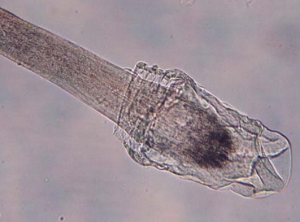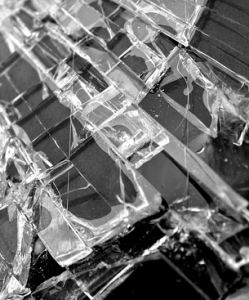Trace Evidence
The presence of trace evidence is particularly dependent on its persistence, as some particles and substances will remain on a surface more readily and for a longer period of time than others. The extent to which evidence will persist depends on the size and shape of the particle, the amount deposited, activity between deposition and recovery, the nature of the environment, and the amount of time passed. Small particles will persist for longer than larger particles, as they are more likely to become lodged in the surface material. Irregular surfaces, such as certain fabrics and wood, will collect particulates more readily than smooth surfaces, as there may be minute crevices for particles to adhere to.
When trace evidence is found, numerous factors should be taken into consideration. The regularity of a material is of great significance, as extremely common items may not be particularly useful. It is trace evidence that is unusual or unique to a particular environment or scene that will be of the greatest importance to an investigation. Some forms of trace evidence may be especially unusual at a scene, giving them particular significance. It should be considered that the lack of trace evidence may either indicate extensive cleaning by the perpetrator or that the event did not occur at that location.
Various methods are employed in the collection of trace evidence, the method used depending on the type and nature of evidence. Larger items, such as long fibres, may be collected by hand or tweezers. One of the simplest methods of recovery is to shake the item over a sheet of paper or container. However this does not allow for the exact location of evidence on the item to be documented. Some particles will not be dislodged by shaking the item, therefore brushing the item may be necessary. A common method of trace evidence collection is the taping technique, particularly beneficial in the case of fibres and hairs. A strip of clear adhesive tape is applied to the surface, peeled off, and placed against backing card. This allows a note to be made of the exact location of the trace evidence. Vacuum lifting is a particularly useful method of trace collection. The scene is divided into smaller grids for the purpose of ease and documentation. The vacuum is used in each grid with a different filter every time. Each individual filter can then be packaged and analysed separately, allowing for the exact grid location of items of evidence to be noted. This method is not as precise as adhesive taping, but it is ideal for collecting particulates.
Fibres
Commonly found at many crime scenes, fibres will either be natural or synthetic. Natural fibres are generally obtained from animal or plant sources, with common examples including cotton, silk and wool. They are generally circular in cross-section and have scalar cuticles. They tend to be readily transferable and often intertwine with other fibres, making them more persistent. The application of heat may cause them to curl. However since the development of nylon in 1939, man-made fibres have increasingly replaced natural fibres in garments in particular. Most natural fibres have distinctive appearances that can be detected using microscopy. However silk and synthetic fibres are produced by drawing out and solidifying a liquid, giving them a smooth and unfortunately indistinguishable surface. These fibres can display a variety of cross-sectional shapes though rarely circular, and are almost always dyed and are less persistent on surfaces. Common examples of synthetic fibres are polyester, nylon and rayon.
Fibres can rarely be used to make an exact positive identification. A side-by-side comparison of a standard sample and the crime scene sample is generally conducted first to compare colour and diameter of the fibres. Morphological features that may aid comparison include striations, the pitting on the fibre’s surface, pigmentation, and the shape of the fibre through a cross-sectional view.
Standard samples should be taken from the crime scene for later comparison with suspect samples. Using microspectrophotometry, light can be are passed through the fibre, some of which is absorbed and some of which passes through the fibre. By examining which wavelengths are absorbed, the nature and colour of the fibre can be determined. Gas chromatography mass spectrometry (GC-MS) is used to study the chemical composition of fibres by analysing the sample to establish individual components. However this is a destructive method which should only be employed following non-destructive analyses.
Hair
Approximately 100 hairs are naturally shed by the human head every day, therefore they are often found at crime scenes. Human hair undergoes a series of three growth phases. Anagen is the growth stage, which can last for up to six years. The catagen stage follows this, which is essentially a transitional phase which lasts for several weeks. Finally is the resting stage, telogen, which can last for up to six months. Examining a collected hair can help establish at what stage in this cycle the hair was. If a hair is pulled during the anagen stage, the root will be bulb-shaped, tapered, and there will most likely be follicular tissue attached. During the catagen stage the root of the hair is long and thin. Finally in the telogen stage, the root is club-shaped and the hair will be shed naturally. Based on morphological features, experts can classify any human hairs found as one of six types; head, facial, eyebrow/eyelash, body, axillary (underarm), and pubic. Hair is composed of the medulla (inner core), the cortex (surrounding layer), and the cuticle (covering layer). The cortex contains the pigment granules which determine the colour of the hair. The outer cuticle resembles a single layer of overlapping scales.
The cortex of the hair surrounds the medulla and consists of both pigment granules and minute air bubbles known as fusi. The cuticle is the layer covering the hair, which consists of a series of overlapping scales. These scale patterns may be coronal, petal or umbricate, their pattern being especially useful in establishing species. Coronal scale patterns are symmetrical and overlapping, not generally being displayed in human hairs (Cheyko & Petreco, 2003). Petal scales are also not found in humans and their appearance resembles the scales of a reptile. Finally umbricate scales, which are overlapping with no apparent pattern, are most commonly found in human hair.
The medulla, the centre section of a hair, is particularly useful for various reasons. The medulla itself can be classified as either absent, fragmented, interrupted, or continuous. Most human head hair will have either no medulla or a fragmented medulla, with the exception of individuals of the mongoloid race, who will typically have a continuous medulla. If the hair is from an animal, the medulla is likely to be continuous or interrupted. The medullary index, expressed as a ratio of shaft diameter to medulla diameter, can be used to distinguish between human and animal hair. The medulla in an animal hair will make up over half of its diameter, whereas it only takes up around one third in human hair.
An examination of the hair found can help determine the origin of the hair, based on its length, shape, size, colour and microscopic appearance. Hairs from the head will often have a split or cut tip, and may have alterations made to them, such as dyes or other chemical applications. Pubic hairs are coarse and wiry in appearance, with a continuous to interrupted medulla. Facial hairs are also coarse in appearance, often with a triangular cross section. Whereas limb hairs are shorter in length and arc-like in shape.
The microscopic examination of human hair can allow for it to be classified into one of three racial groups. Caucasoid or European hairs tend to be of fine to medium coarseness in a range of colours. They are usually straight or wavy, have a round or oval cross-section, and display evenly distributed medium-sized pigment granules. Medium in size, they are generally straight or wavy. Mongoloid/Asian hairs are usually coarse, straight, and circular in cross-section, with a wider diameter and thicker cuticle. Pigment granules are medium-sized and grouped in patches rather than distributed evenly. Negroid hairs tend to be curly with flattened or oval cross-sections and larger pigment granules.
The age of an individual cannot accurately be determined from analysis of hair, though there are some indicators that may be useful. For example, the hair of infants tends to be very fine and usually contains few racial indicators. It is also less likely to be dyed. The hair of an elderly individual may display signs of pigment loss and usually has a variable diameter.
If a hair is forcibly removed, a root will remain bearing tissue ripe for nuclear DNA profiling. However if no root is present it may still be possible to extract mitochondrial DNA. As hair grows out of follicles in the skin, any substances taken in by the body will often be absorbed into the hair, therefore hair can be analysed for the presence of various chemicals. Any drugs and toxins taken in by the individual may appear in the hair, as with certain metals from body piercings. Conversely, the lack of certain materials can also be of significance, such as insufficient amounts of vital nutrients. The exact location of such substances within a hair can act as a kind of timeline, aiding experts in establishing when that substance was taken into the body. Though the analysis of hair can suggest the presence of particular elements and compounds, further tests should be conducted to confirm, such as blood or urine tests.
It may be necessary to collect a number of hairs from a victim or suspect for comparison purposes. Hairs collected from a crime scene are compared with standard samples with the use of a comparison microscope, allowing them to be viewed side by side. To study a cross-section, the hair can be embedded in paraffin wax and sliced into thin sections for examination. The first step in the examination of hair is to establish whether it belongs to a human or an animal. With a comprehensive collection of reference samples available, it may be possible to determine the species of a hair based on its appearance. Human hairs tend to be circular in cross-section, generally making them easily identifiable.
Glass
Glass is an inorganic product of fusion, essentially composed by heating a mix of sand (silicon dioxide, SiO2), limestone (calcium carbonate), and soda (sodium carbonate), along with various impurities. Different types of glass are produced in different ways, and the way in which glass is made causes it to behave variously. Window glass, perhaps the most common type, is generally encountered as a flat, transparent sheet composed of soda-lime glass. This does not resist high temperatures or sudden temperature changes, and can be damaged by corrosive substances. Tempered glass, commonly used in vehicle passenger windows, is much stronger. This strength is achieved by the introduction of extra forces on each side of the glass through the rapid heating and cooling during manufacturing. On impact the glass breaks into small squares, making it particularly useful for use as side and rear windows in cars. However laminated glass is produced with a layer of plastic in between the sheets of glass, holding it together if it breaks. This is often used in car windshields and shop windows. The various forms of glass are coloured by the addition of small amounts of metals, such as cobalt for a blue colouring and chromium for green.
Due to the nature of glass and how it behaves, it may be possible to determine whether two pieces of glass originated from the same source. The density and refractive index of glass can both be used to distinguish between fragments. The density is determined by weighing samples and measuring the volume, using the formula density = mass / volume. The density of two shards of glass can also be determined by suspending the glass in liquid to work out its density. The refractive index of glass is its ability to bend light which passes through it, making it possible to identify the type of glass based on its assigned number, using GRIM (Glass Refractive Index Measurement) apparatus. However it must be taken into account that glass will change its refractive index when heated.
Pieces of broken glass can be physically reconstructed to form the original object or pane. By studying this glass, the investigator may be able to determine which side of the glass the impact came from. When a projectile hits the surface of a glass pane, the glass bends slightly before breaking. This causes radial fractures to occur on the side of the glass opposite the point of impact. If these fractures encounter a pre-existing fracture line they will end, making it possible to establish the order in which the fractures occurred. A fast-moving projectile, such as a bullet, will leave a crater-shaped hole in the pane of glass, whereas a slow-moving projectile will usually shatter the entire pane. Tiny shards of glass will often be found on the clothes of the perpetrator, or anyone else standing in the vicinity when the glass was smashed. Whereas most glass will fall inwards with the impact, fragments will spray in the opposite direction, known as backscatter. These fragments will cling to clothing and footwear even after washing. However about 90% of glass fragments are shed from clothing within 24 hours of deposition.
Paint
Paint is a manufactured liquid that dries to form a thin, hard coating. It is composed of a number of main constituents. These are carriers, pigments, modifiers, extenders and binders. The carrier is the substance that solidifies on evaporation of the solvent, which is usually an organic liquid. The pigment gives the paint its colour, often being a specific substance for certain colours. Blue and green pigments are usually caused by organic compounds, whereas red, yellow and white colours tend to be from inorganic compounds. Modifiers generally control the properties of the paint instead, such as flexibility, gloss, and chip resistance. Extenders, as their name suggests, add volume to the paint and improve its coverage. Finally, binders are natural or synthetic resins which stabilise and enhance the paint.
The analysis of paint can take on three forms; mechanical, physical and chemical. The mechanical analysis will attempt to make matches between flakes of paint, similar to reassembling a jigsaw puzzle. The chemical analysis aims to establish the exact composition of a sample using various chromatography techniques. The physical analysis of paint relates to colour, texture, thickness, appearance, and the pattern of occurrence. All of these can be determined using microscopy.
The paint of automobiles can often be traced back to a specific make and even model, particularly beneficial in hit and run incidents in which paint chips from the suspect car have been left behind at the crime scene. As each car manufacturer will mix paints to a specific formula, two seemingly identical shades can actually have distinct compositions. These fragments may have been transferred to the victim’s clothing, to another vehicle, or simply left on the ground following an impact.



